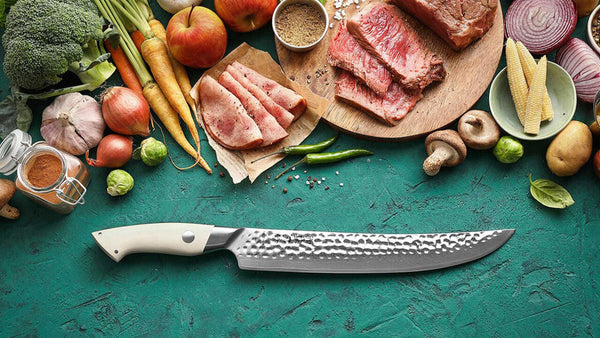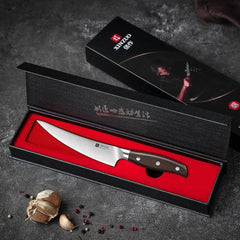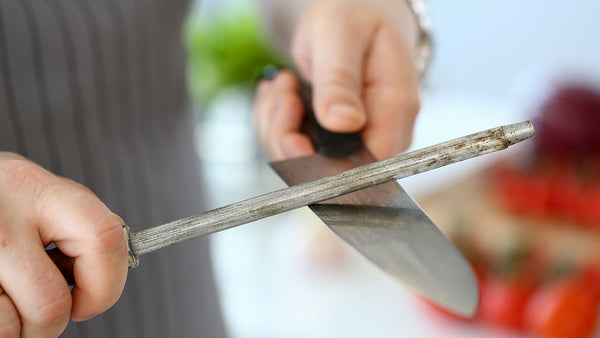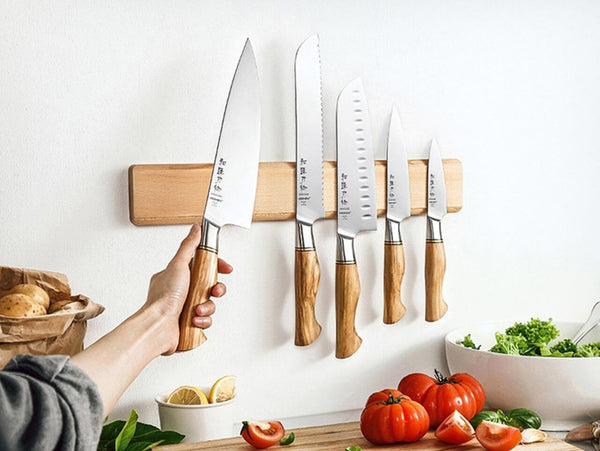
Frequently Asked Questions About Kitchen Knives
Having good kitchen knives is an essential part of not only being able to cook well, but to be able to completely enjoy the cooking process. And, that doesn’t necessarily mean having the fanciest or most expensive knives – it just means having the right knives.
The best way to make sure that you have the right knives for your purposes is to know exactly what makes a good knife – plot twist, it’s not all about the price tag! It all comes down to, firstly, your budget and how many knives you can afford to have, and then what kind of cooking you do and what you would be using your knives for.
The reason we talk about budget straight off the bat is because if you have a massive budget, you could simply buy a massive knife collection and have one (or two) of every type. However, if, like most people, your budget requires you to pick and choose a bit, it’s even more important that you know what you’re looking for. But, even if you do have every single type of different knife, it’s still essential that you know what to use them for and how to use them.
At the Bamboo Guy, we believe in selling our customers the best possible products that we know and trust, but it’s about more than just selling knives. It’s important to us that you know exactly what you’re purchasing so that you can have the best possible experience in the kitchen.
We come across a lot of people who don’t necessarily know a lot about kitchen knives, and since it’s so important to understand what you’re buying and how to use the knives you own, we’ve put together an assortment of questions and answers that’ll help you fill in the blanks.
If you want to learn more about the ins and outs of knives, including some of the most common queries we hear, keeping reading for our list of frequently asked questions about kitchen knives.
1. What is the Most Versatile Kitchen Knife?
A chef’s knife is generally considered the most versatile. It’s pretty big, so you can use it with lots of different types of food, and they tend to be well balanced. You can use them to cut, slice, chop, and dice vegetables, meat, and herbs. However, we wouldn’t recommend using a chef’s knife for deboning or working with anything to hard, like bone or cartilage.
Another option is a Santoku knife, which is often referred to as the Japanese version of a chef’s knife, and it’s also known for its versatility. It’s similar in size, a little bit shorter, but there are two main differences – they often have a double-edged bevel as well as a granton edge. The former basically just means that it’ll work just the same if you’re righthanded or lefthanded, and the latter refers to little dimples on the edge of the blade so the food doesn’t stick to it. For this reason, it’s known by many as more of a vegetable knife, but it can be used for meat too.
The other option is a utility knife, which is easily the most versatile of all the small knives. It’s got a far smaller, shorter, and lighter blade, and it’s small enough to do slightly more intricate, controlled tasks. They’re often serrated.

2. What’s the Best Knife for Chopping Vegetables?
When it comes to chopping vegetables, you have a few different options, and it all depends on how specialized you want and need the knife to be.
A Santoku knife is known as the vegetable knife, and it’s pretty versatile too. The blade is fairly long and the knife is well balanced, so you can use it for pretty much all kinds of vegetables. The other advantage of a Santoku knife is the dimples on the blade that prevent the slices of vegetables from stick to the knife. Nakiri knives are also a great option for vegetables, but they’re a little less versatile and can be more expensive.

Other options include a chef’s knife, as always, or a utility knife for smaller things.
3. What’s the Best Knife for Carving Meat?
Unsurprisingly, the best knife for carving meat is a carving knife. Carving knives tend to have pretty narrow blades with pointed tips – this allows for the knife to grip the meat properly and create precise slices of roasts or poultry.

4. What’s the Best Knife for Working with Fish?
When it comes to working with fish, there are a few different processes to consider. Firstly, there’s filleting – the best knife to use to fillet a fish would obviously be a filleting knife. A filleting knife has a fairly long blade that’s quite narrow and very sharp – it also has a fair amount of flexibility/give to help with precision, as well as a pointed tip for the same reason.

Other knives to consider when working with fish include a sashimi knife, which is ideal for creating thin, precise slices when you’re making sushi or sashimi.
The other option is a Deba knife which is significantly more robust than filleting or sashimi knives. The blade is shorter, broader, and heavier, and a Deba knife can also be used for portioning and breaking down fish, while the former two can’t and shouldn’t.
5. What is the Tang of a Knife?
The tang of a knife is the part of the blade that extends into the handle. Tang affects the weight and balance of the knife, and often the price too. Generally speaking, you normally get knives that are full tang (the blade extends the full length of the handle) or partial tang (the blade extends into only part of the handle).
6. How Do You Sharpen Kitchen Knives?
There are a few different ways to sharpen a knife – using an electric sharpener, a whetstone, or a manual sharpener. The decision comes down to your preference and skill, but the best option is probably a whetstone. The process involves moving the edge of the blade back and forth against the stone at an angle (different angles for different knives) and repeating the process on both sides. Afterwards, you’ll need to hone it.

Check out our extensive guide on knife sharpening for more information.
7. Can You Sharpen Serrated Knives?
Yes, you can sharpen serrated knives, but the process is more difficult, time consuming, and you’ll have to use a honing rod, not a whetstone or any other ordinary tool. You’ll need to precisely and carefully sharpen each serration separately.
8. Do Chopping Boards Affect the Sharpness of Your Knives?
Cutting boards certainly do affect the sharpness of your knives. The general rule is that the harder the board, the more abrasive on the knife. So hard countertops are not recommended, and glass and plastic aren’t great over time. Rubber is okay, but wood is generally considered the best option.
9. What’s the Difference Between a Japanese Knife and a Western Knife?
The differentiation between “Japanese” and “Western” – or, often specifically “German” – is actually more about the style of the design of the knife rather than where it was manufactured.
People generally believe that Japanese knives are superior to Western or German knives, but this isn’t necessarily the case. Knives that are called “Japanese” may still be made cheaply, from low-quality materials, and they could be produced in China, the United States, or just about anywhere else. Conversely, Western or German knives can and may be produced anywhere, from high-quality materials or from inferior materials. So, the designation of “Japanese”, “Western”, or “German” doesn’t specify quality either. It’s all about the style of the design, and generally speaking, Japanese tend to be a bit smaller, lighter, and more delicate in style.
10. What is Damascus Steel?
Damascus steel is a special kind of steel made according to a specific process that replicates the way steel was made in ancient Syria. Today, it’s known as a super strong and durable type of steel for knife blades, and it is also renowned for its unique wavy pattern on the face of the blade.
11. What’s the Best Knife Blade Material?
It all depends on what your priorities are. For instance, stainless steel is resistant to corrosion so it’ll last pretty long and is good for a knife that’s used a lot. Carbon and high-carbon steel are known for their strength. If you can get a combination blade that is both stainless steel and high carbon, that would be a win. Of course, Damascus steel is also strong, long-lasting, high-quality, and aesthetically pleasing – but, it’s more expensive.
12. What’s the Best Way to Store Kitchen Knives?
Avoid storing knives loosely in a drawer where they’ll bump each other and potentially damage the blades. Rather, choose a knife block, a knife magnet, or something that allows the blades to be isolated.

13. What is the Bevel of a Knife?
The bevel of a knife is the slanted angle of the edge of the knife – this is where the sharpness is. Most knives only have a bevel on one side of the blade, but some (mostly Japanese knives like a Santoku knife) have two – this means you can use it the same way in both hands.
14. Does the Material of a Knife Handle Influence the How the Knife Works?
Often, the handle is all about aesthetics, but the weight of the handle will influence the weight and balance of the knife, which will affect your control of the knife.
15. What’s the Difference Between Sharpening and Honing a Knife Blade?
Sharpening a knife blade is about removing part of the blade to restore a dull or damaged lade. Meanwhile, honing is what you do to realign (or straighten) it after sharpening, or if the blade needs a bit of care but not necessarily full-on sharpening.
16. Can You Put High-Quality Knives in the Dishwasher?
It’s normally not a good idea to dishwash your nice knives, and this is true for a few reasons. First, excessive moisture isn’t great for them, and second (most importantly), they often get knocked around which can result in the blades getting damaged. Rather, handwash your nice knives and let them air dry away from other knives and cutlery (like resting on a dish cloth on the counter).
This is the best way to look after high-quality knives.



